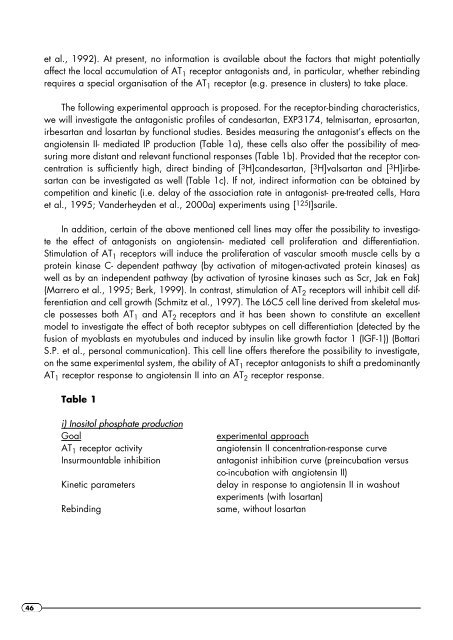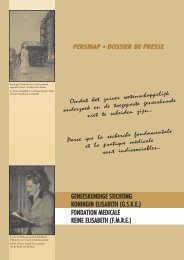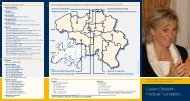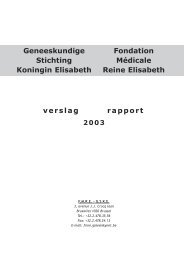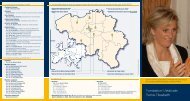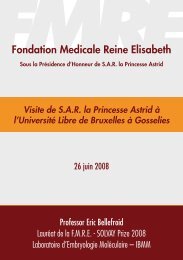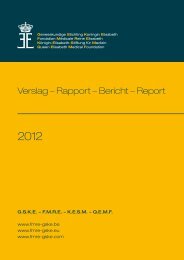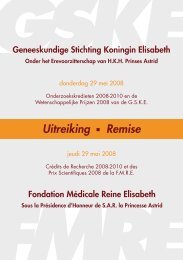Geneeskundige Stichting Koningin Elisabeth ... - GSKE - FMRE
Geneeskundige Stichting Koningin Elisabeth ... - GSKE - FMRE
Geneeskundige Stichting Koningin Elisabeth ... - GSKE - FMRE
Create successful ePaper yourself
Turn your PDF publications into a flip-book with our unique Google optimized e-Paper software.
46<br />
et al., 1992). At present, no information is available about the factors that might potentially<br />
affect the local accumulation of AT 1 receptor antagonists and, in particular, whether rebinding<br />
requires a special organisation of the AT 1 receptor (e.g. presence in clusters) to take place.<br />
The following experimental approach is proposed. For the receptor-binding characteristics,<br />
we will investigate the antagonistic profiles of candesartan, EXP3174, telmisartan, eprosartan,<br />
irbesartan and losartan by functional studies. Besides measuring the antagonist’s effects on the<br />
angiotensin II- mediated IP production (Table 1a), these cells also offer the possibility of measuring<br />
more distant and relevant functional responses (Table 1b). Provided that the receptor concentration<br />
is sufficiently high, direct binding of [ 3H]candesartan, [ 3H]valsartan and [ 3H]irbesartan<br />
can be investigated as well (Table 1c). If not, indirect information can be obtained by<br />
competition and kinetic (i.e. delay of the association rate in antagonist- pre-treated cells, Hara<br />
et al., 1995; Vanderheyden et al., 2000a) experiments using [ 125I]sarile.<br />
In addition, certain of the above mentioned cell lines may offer the possibility to investigate<br />
the effect of antagonists on angiotensin- mediated cell proliferation and differentiation.<br />
Stimulation of AT 1 receptors will induce the proliferation of vascular smooth muscle cells by a<br />
protein kinase C- dependent pathway (by activation of mitogen-activated protein kinases) as<br />
well as by an independent pathway (by activation of tyrosine kinases such as Scr, Jak en Fak)<br />
(Marrero et al., 1995; Berk, 1999). In contrast, stimulation of AT 2 receptors will inhibit cell differentiation<br />
and cell growth (Schmitz et al., 1997). The L6C5 cell line derived from skeletal muscle<br />
possesses both AT 1 and AT 2 receptors and it has been shown to constitute an excellent<br />
model to investigate the effect of both receptor subtypes on cell differentiation (detected by the<br />
fusion of myoblasts en myotubules and induced by insulin like growth factor 1 (IGF-1)) (Bottari<br />
S.P. et al., personal communication). This cell line offers therefore the possibility to investigate,<br />
on the same experimental system, the ability of AT 1 receptor antagonists to shift a predominantly<br />
AT 1 receptor response to angiotensin II into an AT 2 receptor response.<br />
Table 1<br />
i) Inositol phosphate production<br />
Goal experimental approach<br />
AT 1 receptor activity angiotensin II concentration-response curve<br />
Insurmountable inhibition antagonist inhibition curve (preincubation versus<br />
co-incubation with angiotensin II)<br />
Kinetic parameters delay in response to angiotensin II in washout<br />
experiments (with losartan)<br />
Rebinding same, without losartan


